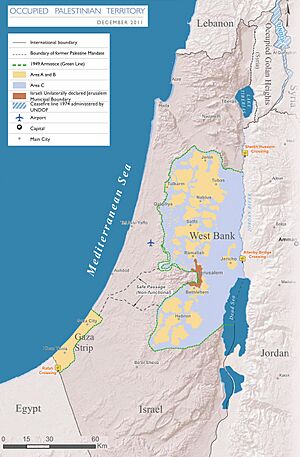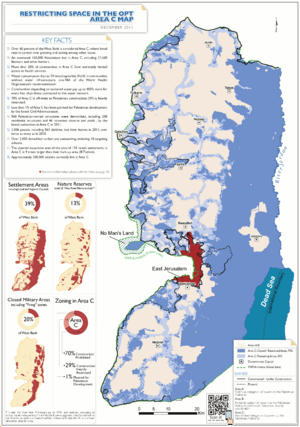Two-state solution facts for kids
The two-state solution is a plan to end the Israeli–Palestinian conflict. It suggests creating two independent countries: an independent State of Palestine and the State of Israel. Both would exist in the land that was once called Mandatory Palestine.
This idea aims to give both Israelis and Palestinians their own safe homelands.
Contents
History of the Two-State Idea
The idea of having separate Jewish and Arab states in this area is not new.
Early Proposals
- In 1937, a British group called the Peel Commission first suggested dividing the land.
- In 1947, the United Nations (UN) voted for a plan to divide Palestine. This plan led to the 1948 Palestine war.
- After the 1948 war, Israel was created. It took control of the area the UN suggested for a Jewish state. Israel also took some land meant for the Arab state.
- West Jerusalem became part of Israel, even though it was planned to be an international zone.
- Jordan took control of East Jerusalem and the area now known as the West Bank.
- Egypt occupied the Gaza Strip.
After the 1967 War
- In 1967, the Six-Day War happened. After this war, Israel took control of both the West Bank (including East Jerusalem) and the Gaza Strip. These areas became known as the Palestinian territories.
Peace Efforts and Challenges
Many groups and countries have tried to make the two-state solution happen.
Palestinian Views
- The Palestine Liberation Organization (PLO) is a main Palestinian group. They have generally accepted the idea of a two-state solution since 1982. Before that, they had said no to similar plans since 1937.
- In 2017, Hamas, another Palestinian group, released a new plan. It said they would accept a Palestinian state based on the 1967 borders. However, Hamas still does not recognize Israel as a country.
Diplomatic Talks
- Many peace talks have focused on the two-state solution.
- One important meeting was the 2000 Camp David Summit. It did not succeed in reaching an agreement.
- The failure of the Camp David talks led to the start of the Second Intifada. This was a period of violence. It made many Israelis feel less hopeful about a Palestinian state.
- Other peace efforts include the Arab Peace Initiative and talks in 2013-2014.
- Despite these challenges, many countries around the world still support the two-state solution.
Main Disagreements
There are several big issues that make it hard to agree on a two-state solution:
- Borders: Deciding exactly where the borders between the two states would be. Most plans suggest using the 1967 borders.
- Jerusalem: The status of Jerusalem is a very sensitive issue. Both Israelis and Palestinians see Jerusalem as their capital.
- Settlements: The Israeli settlements are communities built by Israelis in the West Bank. Palestinians see these as a barrier to their state.
- Refugees: The right of return refers to Palestinian refugees who left or were forced to leave their homes in 1948. They wish to return.
Other Ideas
Some people think the two-state solution is no longer possible. They point out that Israel controls most of the land. This situation is sometimes called a de facto (meaning "in reality") one-state reality.
- An alternative idea is the one-state solution. This plan suggests having one country where both Israelis and Palestinians live together.
See also
 In Spanish: Solución de dos Estados para niños
In Spanish: Solución de dos Estados para niños
- List of Middle East peace proposals
- One-state solution
- Palestinianism
- Greater Palestine
- State of Judea
- United Nations Partition Plan for Palestine
- Zionism




